Goldfish are a popular choice for pet owners due to their vibrant colors and easy maintenance. These lovely aquatic pets can be found in countless aquariums around the world, captivating fish lovers with their shimmering scales, movements, and colors. However, providing the right nutrition is crucial for their health and longevity.
Feeding goldfish requires more than just tossing in some flakes or pellets and calling it a day. Understanding goldfish nutrition and feeding guidelines is essential to keep them healthy and thriving.
Whether you’re a seasoned aquarist or just dipping your toes into the waters of goldfish keeping, our expert-backed guide has something invaluable for you.
Our aim? To arm you with the knowledge you need to keep your goldfish not just surviving, but thriving. We delve into the essential dos and don’ts of goldfish nutrition, breaking down complex topics into easy-to-digest advice that will leave you confident in your feeding regimen.
This comprehensive guide covers key areas such as the most nutritious food types, the ideal feeding schedule, and portion control to prevent overfeeding. So grab your notepad and prepare to dive in—let’s craft the perfect dining experience for your colorful aquatic companions.
Contents
Understanding Goldfish Nutrition
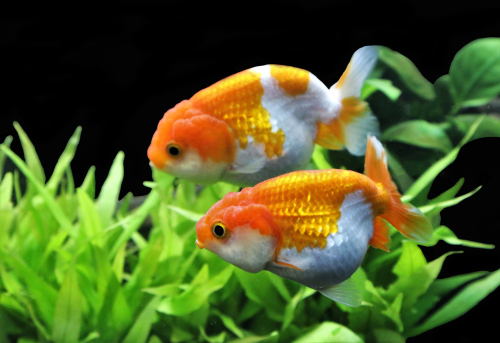
Goldfish are omnivores, which means they require a balanced diet that includes both plant and animal-based foods. Understanding the nutritional needs of your goldfish is essential to keep them healthy and happy.
Proteins and Fats
Proteins and fats are essential nutrients for goldfish and play a vital role in their growth and development. Goldfish require a diet that is high in protein, which can be found in foods such as shrimp, krill, and worms.
Fats are also important for goldfish, as they provide energy and help with the absorption of vitamins. Foods that are high in fat include salmon, trout, and herring.
Vitamins and Minerals
Vitamins and minerals are also essential for goldfish and help to keep their immune system strong. Vitamin C is particularly important for goldfish, as it helps to prevent diseases and keep their skin healthy.
Foods that are high in vitamin C include oranges, broccoli, and spinach. Calcium is also important for goldfish, as it helps to keep their bones strong. Foods that are high in calcium include kale, collard greens, and spinach.
Carbohydrates and Fiber
Carbohydrates and fiber are also important for goldfish, as they provide energy and help to keep their digestive system healthy. Foods that are high in carbohydrates include peas, corn, and beans. Fiber can be found in foods such as lettuce, cabbage, and spinach.
In summary, a balanced diet that includes protein, fats, vitamins, minerals, carbohydrates, and fiber is essential for the health and well-being of goldfish. It is important to provide a variety of foods to ensure that your goldfish receives all the necessary nutrients.
Types of Goldfish Food
When it comes to feeding goldfish, there are a variety of options available. Here are some of the most common types of goldfish food:
Flakes and Pellets
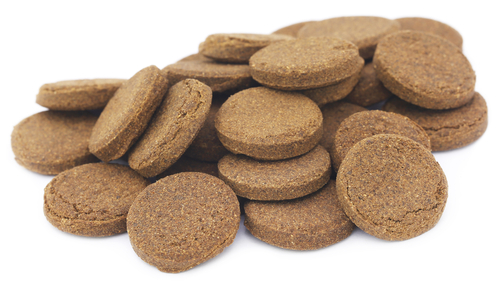
Flake and pellet foods are the most popular types of goldfish food. They are convenient, easy to store, and come in a variety of formulas designed to meet the nutritional needs of different types of goldfish.
Pellets are generally larger than flakes and sink to the bottom of the tank, making them a good choice for bottom-feeders.
Live and Frozen Foods
Live and frozen foods can provide goldfish with additional nutrients and variety in their diet. Some popular live and frozen foods for goldfish include brine shrimp, blood worms, and daphnia.
However, it is important to make sure that any live or frozen food is properly cleaned and prepared before feeding it to your goldfish.
Vegetables and Fruits
Goldfish are omnivores and can benefit from a diet that includes vegetables and fruits. Some good options include peas, spinach, zucchini, and cucumber.
These foods should be blanched or cooked before feeding them to your goldfish to make them easier to digest.
Hair Algae and Small Plants
Goldfishes are largely herbivores; given the opportunity, goldfish would gladly feed on the aquarium plants. On the other hand, your goldfish might enjoy the overgrowth of plants or algae in another tank as a dietary source. For a thorough cleaning, briefly relocate hair algae into your goldfish aquarium.

Trim your overgrown stem plants and remove any extra floating plants before adding the cuttings to your goldfish tank. If duckweed covers the whole surface of the water in your tank, you might want to consider moving a goldfish into the affected aquarium and they will do the needful by ensuring the duckweed is entirely wiped out.
Specialty Foods
There are also specialty foods available for goldfish, including gel foods and freeze-dried foods. Gel foods are made by mixing a powdered food with water to create a gel-like consistency.
Freeze-dried foods are made by freeze-drying various types of food, such as krill or shrimp. These types of foods can provide additional variety in your goldfish’s diet, but should not be the sole source of their nutrition.
Overall, it is important to provide a balanced diet for your goldfish that includes a variety of foods. It is also important to avoid overfeeding, as this can lead to health problems.
Some popular brands of goldfish food include Hikari and Tetra, but there are many other options available as well.
Feeding Guidelines
house rules. You can be feeding your goldfish the right food, but if not done rightly, you may never get your desired results. In light of this, here are some basic and most followed guidelines for feeding goldfish.
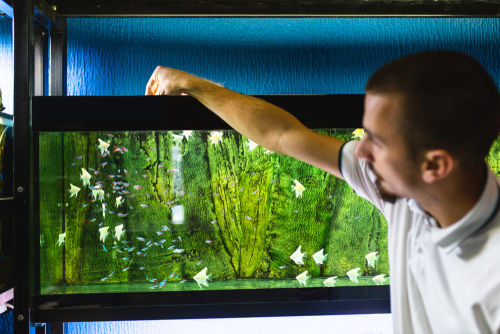
Amount and Frequency
A good rule of thumb is to feed a goldfish once or twice a day, giving them only what they can eat in about 2-3 minutes. It’s important not to overfeed your goldfish as this can lead to health problems such as swim bladder disease and poor water quality.
The amount of food your goldfish needs will depend on its size and age. As a general guideline, feed a goldfish about 1-2% of its body weight per day. For example, if your goldfish weighs 10 grams, it should be fed about 0.1-0.2 grams of food per day.
Avoiding Overfeeding
Overfeeding is a common problem among goldfish owners. It’s important to remember that goldfish have small stomachs and can only eat so much at one time.
Overfeeding can lead to health problems such as constipation, bloating, and swim bladder disease.
To avoid overfeeding, it’s important to stick to a regular feeding schedule and only give your goldfish what it can eat in a few minutes. If you notice your goldfish is not finishing its food, try reducing the amount you give it or feeding it less often.
Feeding During Travel
If you’re going on vacation or need to be away from home for an extended period of time, it’s important to make sure your goldfish is still getting the proper nutrition it needs. There are a few options for feeding your goldfish while you’re away.
One option is to use an automatic feeder. These devices can be programmed to dispense food at specific times throughout the day.
Another option is to have a friend or neighbor come over and feed a goldfish while you’re away. Be sure to provide clear instructions on how much and how often to feed a goldfish.
A good tip is to use a pill box with the week days written on and pre-fill with the amount of food that you would normally feed. This way mistakes and over feeding can be avoided by the persons you have left in charge of feeding your fish.
Overall, it’s important to remember that a balanced diet and proper feeding schedule are essential for the health and well-being of your goldfish.
By following these feeding guidelines, you can help ensure your goldfish lives a long and healthy life.
Special Feeding Considerations
It is rewarding to see your goldfish vibrant and active, but that doesn’t just happen. There are some special considerations that you must have in mind. Keep in mind that goldfish dietary needs may vary based on age, size, season, and species. So, staying attuned to their behaviors and nutritional needs is vital. Here, we look at some key factors to consider.
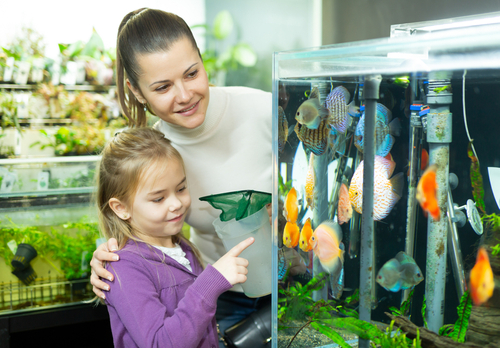
For Young and Old Goldfish
When feeding young goldfish, it is important to provide them with small, frequent feedings throughout the day. This will help them grow and develop properly.
As goldfish age, their metabolism slows down, and they require less food. Older goldfish should be fed less frequently and in smaller quantities to avoid overfeeding and potential health issues, such as constipation.
For Fancy Goldfish
Fancy goldfish have egg-shaped bodies and are more prone to swim bladder problems than other goldfish varieties. It is important to feed a goldfish a diet that is specifically formulated for their needs.
Fancy goldfish should be fed a high-quality pellet or gel food that is low in carbohydrates and high in protein. It is also important to avoid overfeeding them, as this can lead to swim bladder disorder.
During Illness
When a goldfish is sick, its appetite may decrease. It is important to continue feeding the goldfish, but in smaller quantities and more frequently. It may also be necessary to switch to a softer, more easily digestible food such as peas or boiled vegetables.
It is important to monitor the goldfish’s body condition and adjust its diet accordingly. If the goldfish is constipated, it may be necessary to add a small amount of Epsom salt to its diet to help alleviate the problem.
In summary, feeding a goldfish requires special considerations based on their age, variety, and health status. By providing a balanced diet and monitoring their body condition, goldfish can thrive and live a long, healthy life.
The Impact of Water Quality and Temperature
Ensuring the health and well-being of your fish does not end with feeding alone, water quality and temperature must meet certain requirements in order to get the desired results. This section will look at the water parameters and temperature required for the optimal performance of your goldfish.
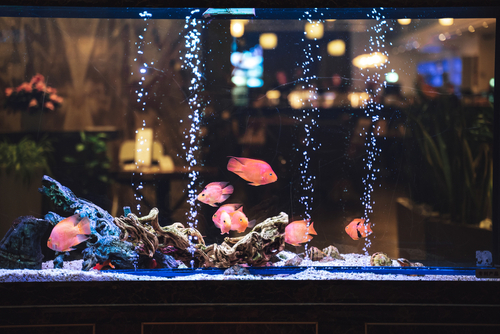
Water Quality
Water quality is crucial for the health and well-being of goldfish. Poor water quality can lead to a variety of health problems, including stress, disease, and even death.
It is important to maintain good water quality by monitoring water parameters such as pH, ammonia, nitrite, and nitrate levels.
Goldfish produce waste constantly, which can quickly build up and create toxic conditions in the aquarium.
Regular water changes are necessary to remove waste and maintain good water quality. It is recommended to change 10-20% of the water every week to keep the water clean and healthy for goldfish.
In addition to regular water changes, using a high-quality filter can help keep the water clean. A filter should be appropriately sized for the aquarium and should be cleaned regularly to ensure it is working properly.
Temperature
The temperature of the water is also important for goldfish health. Goldfish are cold water fish and prefer temperatures between 65-75°F (18-24°C). Water that is too warm can cause stress and increase the risk of disease.
It is important to use a reliable aquarium thermometer to monitor the temperature of the water.
If the temperature is too high, the aquarium should be moved to a cooler location, or a fan or chiller can be used to lower the temperature. If the temperature is too low, a heater can be used to raise the temperature.
In conclusion, maintaining good water quality and temperature is essential for the health and well-being of goldfish. Regular water changes, using a high-quality filter, and monitoring the temperature of the water are all important factors in keeping goldfish healthy and happy.
Common Myths and Misconceptions
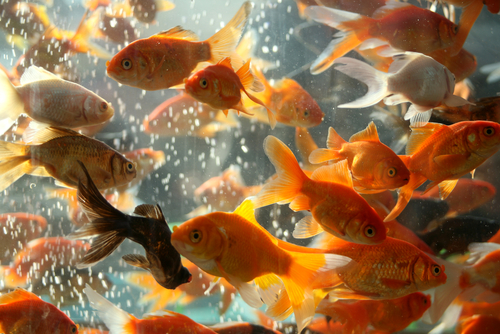
There are several common myths and misconceptions about feeding goldfish that can harm their health. Here are a few of the most prevalent ones:
Goldfish can survive on just flakes or pellets.
While flakes and pellets are a convenient and popular choice for feeding goldfish, they should not be the only food source. Goldfish also need a variety of fresh vegetables, such as peas and lettuce, to supplement their diet and promote digestion.
Goldfish can eat any human food.
While it may be tempting to feed a goldfish scraps from the dinner table, many human foods can be harmful to them. Foods high in salt, sugar, and fat can cause health issues, and some foods, such as avocado and chocolate, are toxic to goldfish.
Goldfish can eat the same food as wild fish.
Goldfish have been domesticated for centuries and have different nutritional needs than wild fish. While wild fish may survive on a diet of insects and algae, goldfish require a more varied diet that includes both plant and animal matter.
Goldfish can go without food for long periods.
While goldfish can survive for several days without food, they should not be left without food for extended periods. A lack of food can weaken their immune system and make them more susceptible to disease.
Frequently Asked Questions
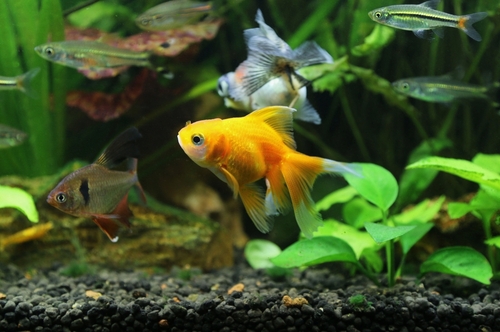
What are some suitable foods for small goldfish?
Small goldfish can eat a variety of foods, including flakes, pellets, and frozen or live foods such as brine shrimp and bloodworms.
It’s important to choose a high-quality fish food that is specifically formulated for goldfish. Avoid feeding your goldfish human foods or foods that are high in fat, as these can cause health problems.
How much should I feed a goldfish?
The amount of food you should feed a goldfish depends on their size and age. As a general rule, you should feed a goldfish a small amount of food once or twice a day.
Only feed a goldfish what they can eat in 2-3 minutes, as overfeeding can lead to health problems such as obesity and swim bladder disease.
What is the ideal diet for goldfish?
The ideal diet for goldfish is one that is high in protein and low in fat. Goldfish require a balanced diet that includes both plant-based and animal-based foods.
Look for fish foods that contain a mixture of flakes, pellets, and freeze-dried or frozen foods such as brine shrimp and bloodworms.
Can goldfish eat vegetables and fruits?
Yes, goldfish can eat vegetables and fruits such as lettuce, peas, and cucumber. However, these should be offered in moderation and should not replace a balanced fish food diet.
Make sure to remove any uneaten vegetables or fruits from the tank after a few hours to prevent water quality issues.
What can I feed my goldfish if I don’t have fish food?
If you don’t have fish food on hand, you can feed a goldfish small amounts of cooked vegetables such as peas or spinach.
You can also offer small amounts of boiled or cooked chicken or beef, but make sure to remove any bones or fat. Avoid feeding your goldfish human foods that are high in salt, sugar, or fat.
How long can goldfish go without food?
Goldfish can go several days without food, but it’s not recommended to starve them for long periods of time.
If you need to go away for a few days, you can purchase an automatic fish feeder that will dispense small amounts of food at set intervals. However, it’s important to make sure the feeder is working properly before leaving your goldfish unattended.
Key Takeaways on What to Feed a Goldfish
- A balanced diet for goldfish includes a variety of foods such as pellets, flakes, frozen or live foods, and vegetables.
- Overfeeding or feeding the wrong types of food can lead to health problems such as swim bladder disease, constipation, and obesity.
- Understanding goldfish nutrition and feeding guidelines is essential to keep them healthy and thriving.
You will also like these other popular posts in this category:

Veteran fish keeper and keen hobbyist with a serious case of MTS. My midlife crisis was the establishment of a fish room, much to my wife’s horror. Little does she know it could be worse!!


